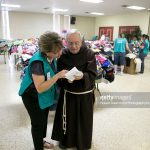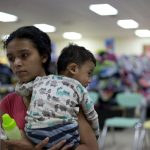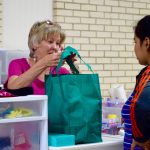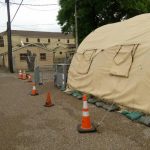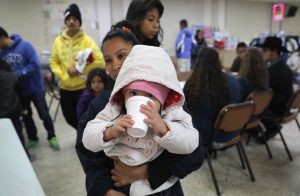Immigration Shelter Sponsored by Catholic Charities:
The Struggles of Central & Southern American Immigrants Crossing the Texas-Mexico Border
About the Shelter
In the summer of 2014, Sacred Heart Church in McAllen, Texas, along with volunteers from all over the country, has been assisting illegal immigrants entering the country after being detained by U.S. Immigration and Customs Enforcement. Their mission, to provide clothes, food, a safe space, and even medical care for undocumented Central and Southern American (primarily women and children from Honduras, El Salvador, and Guatemala) immigrants and their families. Sister Norma Pimentel serves as the Executive Director of the Catholic Charities of the Rio Grande Valley, and most of the resources provided to immigrants are donations. The facility consists of a large warehouse and tents located behind Sacred Heart Church. The location of the shelter, downtown McAllen, is primordial since it is close to the McAllen Bus Terminal where ICE releases the immigrants and volunteers from the shelter drop them off to continue their journeys into the States. This shelter welcomed as little as 50 immigrants to as many as 200 immigrants per day.
Immigration Shelter General Information
A Physical Border
McAllen, Texas is situated in the heart of the Rio Grande Valley, a region named after the famous Rio Grande River that provides a physical border to separate the U.S. from Mexico. Besides the river, other forms of physical obstacles meant to deter illegal immigrants from crossing the contested border are present-- usually in the form of fences. Many of the immigrants coming to the shelter leave their countries due to to high poverty rates and small opportunity for economic advancement. However, most of them flee their country due to gang-related violence.
To view where border fences are present along the U.S.- Mexico border, view this page:
The Journey
The stories of many of the immigrants I worked with resonated with those told in films about immigrants such as La Misma Luna. Many of them scraped barely enough money to escape their homelands to make the long journey across Mexico, a dangerous place for immigrants because of untrustworthy coyotes and narcos. A lot of the women and children were on their way to northern states to reunite with their husbands or extended family.
Some of the stories they told included being kidnapped by narcos in Mexico and miraculously making it out alive, swimming across the Rio Grande River, and women often related they had been sexually assaulted or raped by the people transporting them from one location to another. As they traveled from Central and Southern America to American territory, they did not have a chance to shower. After being caught by U.S. Border Patrol, they arrived to ICE, often referred to as the "hielera" meaning "cooler" in English because of the how cold the buildings are, dirty, tired, and anxiety-ridden. Their possessions were often a backpack with important phone numbers, documents, and little money. They arrived to the shelter looking weary and like criminals since ICE stripped them of shoelaces and some were given ankle monitors.
Because directors and volunteers were aware of the circumstances these individuals had endured, they were greeted with applause once they entered the shelter. They were provided documents that explained their legal status and rules as well as a folder stating, "HELP. I DON'T SPEAK ENGLISH. CAN YOU PLEASE TELL ME WHAT BUS TO TAKE?" Lawyers who would volunteer to assist these immigrants without charge would explain their situations and advice them. Most immigrants did not stay more than two days at the shelter.
Read more on the reasons for illegal immigration:
Immigrants Fleeing their Home Countries and Statistics about Crossing the Border
Information on ICE's treatment of illegal child immigrants:
Destinations
Immigrants often traveled to northern states by bus, especially the East Coast, where family members waited for them. Although under U.S. law, they are not supposed to work, many of them were eager to reach their destinations and earn money. Many of them are unsure of their future or whether they will be in the U.S. long enough to fulfill their dreams.
My Personal Experience with the Shelter & Immigration
I began volunteering at this shelter since it opened. Working with immigrants was such a humbling and eye-opening experience. I recall helping a mother shower her girls inside the portable showers that were located out in the open air. It was January and although McAllen is known for its mild winters, the temperature was chilly. The little girl was shivering and did not want to step inside the shower and kept on saying, "está frío," to which her mother responded "el Río Grande estaba más frío y como quiera te metiste." Another lady with two kids only carried $20 for her 3 day bus trip to North Carolina.
These experiences made me realize how resilient these individuals were. They had struggled crossing Mexico, the physical border, and were now headed to the unknown. A foreign land where they could not communicate properly and were more than likely going to experience discrimination.
When Donald Trump assumed power in January of 2017, the number of immigrants significantly dropped as his administration holds a strong stance against immigration and his successful campaign revolved around building a wall. Fortunately, because South Texas is dominated by Latinos, many of the residents in the area are advocates for illegal immigrants' rights. Most people hold positive views about immigration and it is reflected in the amount of help and donations the shelter receives.
Latina actress, America Ferrera, visited the shelter on July 27, 2014 with the Hispanic Heritage Foundation.
Executive Director, Sister Norma Pimentel, cradles a newborn immigrant child at the shelter.
A child and mother are pictured near the dining area of the shelter receiving food.
Immigrants and their children wait to register outside of the shelter.
Sources:
http://sacredheartchurch-mcallen.org/immigrant-assistance/general-information/
http://www.themonitor.com/news/article_8aa6983c-16c6-11e4-a4b4-0017a43b2370.html
http://www.latimes.com/nation/la-na-immigrant-family-separations-2018-story.html


